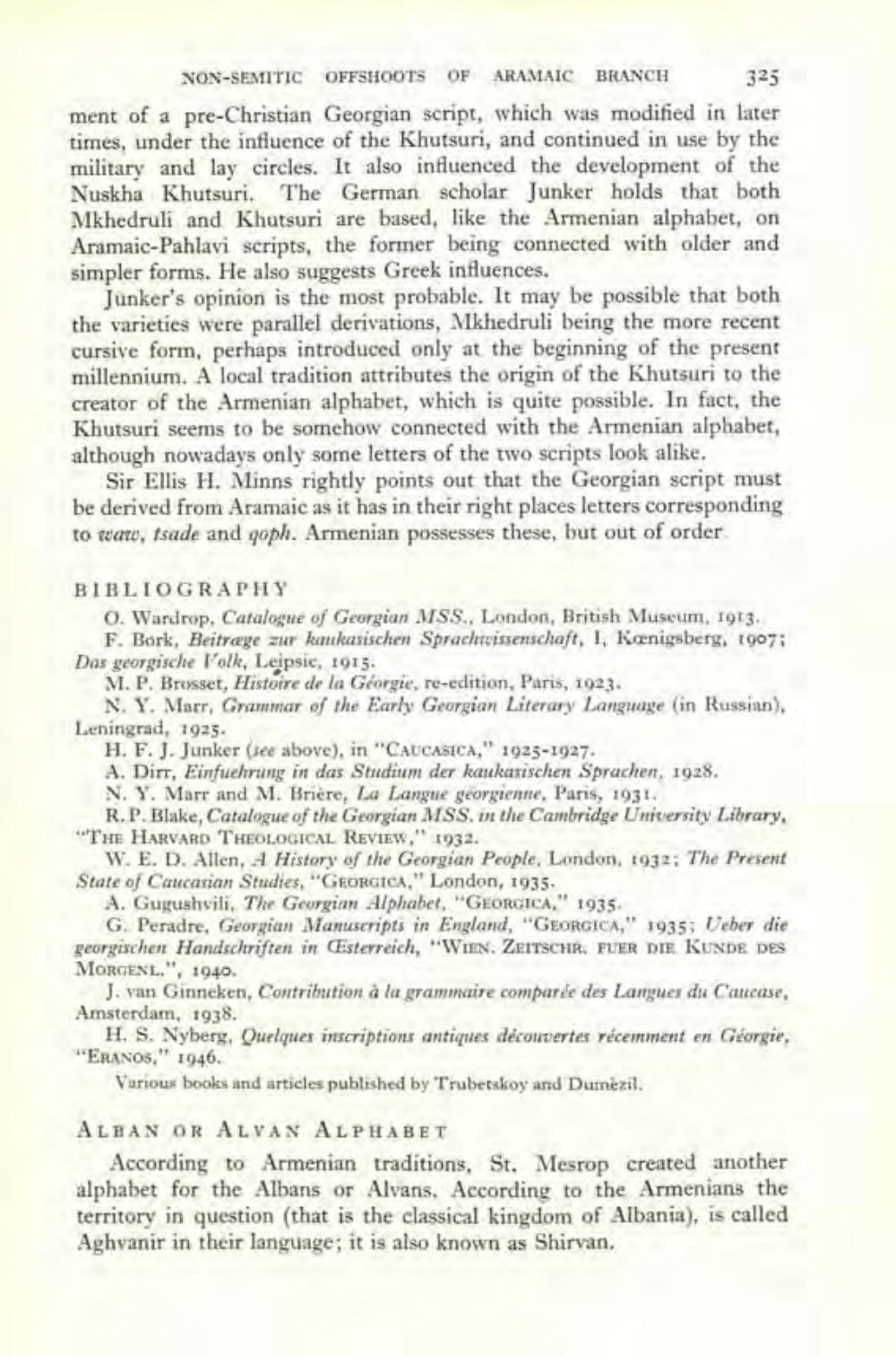________________
NON-SEMITIC
OFFSHOOTS OF ARAMAIC BRANCH
325 ment of a pre-Christian Georgian script, which was modified in later times, under the influence of the Khutsuri, and continued in use by the military and lay circles. It also influenced the development of the Nuskha Khutsuri. The German scholar Junker holds that both Mkhedruli and Khutsuri are based, like the Armenian alphabet, on Aramaic-Pahlavi scripts, the former being connected with older and simpler forms. He also suggests Greek influences.
Junker's opinion is the most probable. It may be possible that both the varieties were parallel derivations, Mkhedruli being the more recent cursive form, perhaps introduced only at the beginning of the present millennium. A local tradition attributes the origin of the Khutsuri to the creator of the Armenian alphabet, which is quite possible. In fact, the Khutsuri seems to be somehow connected with the Armenian alphabet, although nowadays only some letters of the two scripts look alike.
Sir Ellis H. Minns rightly points out that the Georgian script must be derived from Aramaic as it has in their right places letters corresponding to waw, tsade and goph. Armenian possesses these, but out of order
BIBLIOGRAPHY
O. Wardrop, Catalogue of Georgian MSS., London, British Museum, 1913. F. Bork, Beitrage zur kaukasischen Sprachwissenschaft, I, Koenigsberg, 1907; Das georgische Volk, Leipsic, 1915.
M. P. Brosset, Histoire de la Géorgie, re-edition, Paris, 1923.
N. Y. Marr, Grammar of the Early Georgian Literary Language (in Russian), Leningrad, 1925.
H. F. J. Junker (see above), in "CAUCASICA," 1925-1927.
A. Dirr, Einfuehrung in das Studium der kaukasischen Sprachen, 1928.
N. Y. Marr and M. Brière, La Langue géorgienne, Paris, 1931.
R. P. Blake, Catalogue of the Georgian MSS. in the Cambridge University Library, "THE HARVARD THEOLOGICAL REVIEW," 1932.
W. E. D. Allen, A History of the Georgian People, London, 1932: The Present State of Caucasian Studies, "GEORGICA," London, 1935
A. Gugushvili, The Georgian Alphabet, "GEORGICA," 1935
G. Peradre, Georgian Manuscripts in England, "GEORGICA," 1935; Ueber die georgischen Handschriften in Esterreich, "WIEN. ZEITSCHR. FUER DIE KUNDE DES MORGENL.", 1940.
J. van Ginneken, Contribution à la grammaire comparée des Langues du Caucase, Amsterdam, 1938.
H. S. Nyberg, Quelques inscriptions antiques découvertes récemment en Géorgie, "ERANOS," 1946.
Various books and articles published by Trubetskoy and Dumezil.
ALBAN OR ALVAN ALPHABET
According to Armenian traditions, St. Mesrop created another alphabet for the Albans or Alvans. According to the Armenians the territory in question (that is the classical kingdom of Albania), is called Aghvanir in their language; it is also known as Shirvan.




